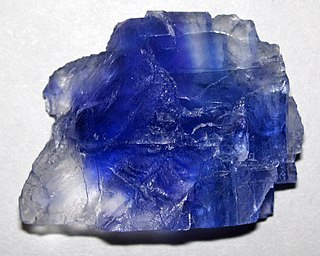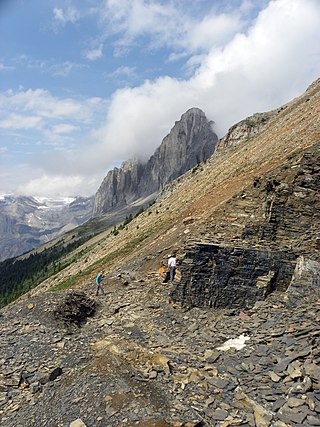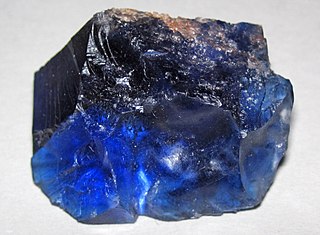
Limestone is a type of carbonate sedimentary rock which is the main source of the material lime. It is composed mostly of the minerals calcite and aragonite, which are different crystal forms of CaCO3. Limestone forms when these minerals precipitate out of water containing dissolved calcium. This can take place through both biological and nonbiological processes, though biological processes, such as the accumulation of corals and shells in the sea, have likely been more important for the last 540 million years. Limestone often contains fossils which provide scientists with information on ancient environments and on the evolution of life.
Called the Windermere Group in the United States and the Windermere Supergroup, Windermere Series, and Windermere System in Canada, the Windermere sequence of North America is an extensive assemblage of sedimentary and volcanic rocks of latest Precambrian (Neoproterozoic) age. It is present in the northern part of the North American Cordillera, stretching from Montana, Idaho, and Washington in the northwestern United States, through Alberta, British Columbia, the Northwest Territories, and the Yukon in western Canada. It was named for the Windermere map-area in the East Kootenay region of southeastern British Columbia by J.F. Walker in 1926.

The Elk Point Group is a stratigraphic unit of Early to Middle Devonian age in the Western Canada and Williston sedimentary basins. It underlies a large area that extends from the southern boundary of the Northwest Territories in Canada to North Dakota in the United States. It has been subdivided into numerous formations, number of which host major petroleum and natural gas reservoirs.
The Red River Formation is a stratigraphical unit of Late Ordovician age in the Williston Basin.

The Cathedral Formation is a stratigraphic unit in the southern Canadian Rockies of Alberta and British Columbia, on the western edge of the Western Canada Sedimentary Basin. It is a thick sequence of carbonate rocks of Middle Cambrian age. It was named for Cathedral Mountain in Yoho National Park by Charles Doolittle Walcott, the discoverer of the Burgess shale fossils.

The Deadwood Formation is a geologic formation of the Williston Basin and Western Canada Sedimentary Basin. It is present in parts of North and South Dakota and Montana in the United States, and in parts of Alberta, Saskatchewan, and southwestern corner of Manitoba in Canada. It is of Late Cambrian to Early Ordovician age and was named for exposures in Whitewood Creek near Deadwood, South Dakota. It is a significant aquifer in some areas, and its conglomerates yielded significant quantities of gold in the Black Hills of South Dakota.
The Favel Formation is a stratigraphic unit of Late Cretaceous age. It is present in southern Manitoba and southeastern Saskatchewan, and consists primarily of calcareous shale. It was named for the Favel River near Minitonas, Manitoba, by R.T.D. Wickenden in 1945.
The Flume Formation is a geologic formation in the Western Canada Sedimentary Basin in Alberta, Canada. It was deposited as an extensive carbonate platform along the western edge of the basin during Late Devonian (Frasnian) time and the reefs of the Cairn Formation subsequently developed on it.
The Beaverfoot Formation is a stratigraphic unit of Late Ordovician to Early Silurian (Llandovery) age. It is present on the western edge of the Western Canada Sedimentary Basin in the Rocky Mountains of British Columbia and Alberta, and the Purcell Mountains of British Columbia. It consists of carbonate rocks, and was named for the Beaverfoot Range at Pedley Pass southeast of Golden, British Columbia by L.D. Burling in 1922.
The Skoki Formation is a stratigraphic unit of Early to Middle Ordovician age that is present on the western edge of the Western Canada Sedimentary Basin in the Canadian Rockies of Alberta and British Columbia. It was named for Skoki Mountain near Lake Louise in Banff National Park by Charles Doolittle Walcott in 1928. The Skoki Formation is fossiliferous and includes remains of brachiopods and other marine invertebrates, as well as conodonts and oncolites.
The Sulphur Mountain Formation is a geologic formation of Early to Middle Triassic age. It is present on the western edge of the Western Canada Sedimentary Basin in the foothills and Rocky Mountains of western Alberta and northeastern British Columbia. It includes marine fossils from the time shortly after the Permian-Triassic extinction event.
The Mount Whyte Formation is a stratigraphic unit that is present on the western edge of the Western Canada Sedimentary Basin in the southern Canadian Rockies and the adjacent southwestern Alberta plains. It was deposited during Middle Cambrian time and consists of shale interbedded with other siliciclastic rock types and limestones. It was named for Mount Whyte in Banff National Park by Charles Doolittle Walcott, the discoverer of the Burgess shale fossils, and it includes several genera of fossil trilobites.

The mining industry of Yemen is at present dominated by fossil mineral of petroleum and liquefied natural gas (LNG), and to a limited extent by extraction of dimension stone, gypsum, and refined petroleum. Reserves of metals like cobalt, copper, gold, iron ore, nickel, niobium, platinum-group metals, silver, tantalum, and zinc are awaiting exploration. Industrial minerals with identified reserves include black sands with ilmenite, monazite, rutile, and zirconium, celestine, clays, dimension stone, dolomite, feldspar, fluorite, gypsum, limestone, magnesite, perlite, pure limestone, quartz, salt, sandstone, scoria, talc, and zeolites; some of these are under exploitation.

The Prairie Evaporite Formation, also known as the Prairie Formation, is a geologic formation of Middle Devonian (Givetian) age that consists primarily of halite and other evaporite minerals. It is present beneath the plains of northern and eastern Alberta, southern Saskatchewan and southwestern Manitoba in Canada, and it extends into northwestern North Dakota and northeastern Montana in the United States.
The geology of Ohio formed beginning more than one billion years ago in the Proterozoic eon of the Precambrian. The igneous and metamorphic crystalline basement rock is poorly understood except through deep boreholes and does not outcrop at the surface. The basement rock is divided between the Grenville Province and Superior Province. When the Grenville Province crust collided with Proto-North America, it launched the Grenville orogeny, a major mountain building event. The Grenville mountains eroded, filling in rift basins and Ohio was flooded and periodically exposed as dry land throughout the Paleozoic. In addition to marine carbonates such as limestone and dolomite, large deposits of shale and sandstone formed as subsequent mountain building events such as the Taconic orogeny and Acadian orogeny led to additional sediment deposition. Ohio transitioned to dryland conditions in the Pennsylvanian, forming large coal swamps and the region has been dryland ever since. Until the Pleistocene glaciations erased these features, the landscape was cut with deep stream valleys, which scoured away hundreds of meters of rock leaving little trace of geologic history in the Mesozoic and Cenozoic.
The Kananaskis Formation is a geologic formation that is present on the western edge of the Western Canada Sedimentary Basin in the southern Canadian Rockies of western Alberta. Named after the Kananaskis Range near Banff, it was deposited during the Late Pennsylvanian sub-period of the Carboniferous period. Some of its strata host fossils of marine invertebrates.

The Eldon Formation is a stratigraphic unit that is present on the western edge of the Western Canada Sedimentary Basin in the southern Canadian Rockies of southwestern Alberta and southeastern British Columbia. It is a thick sequence of massive, cliff-forming limestones and dolomites that was named for Eldon Switch on the Canadian Pacific Railway near Castle Mountain in Banff National Park by Charles Doolittle Walcott, who discovered the Burgess Shale fossils. The Eldon Formation was deposited during Middle Cambrian time, and it includes fossil stromatolites. The Eldon forms the scenic cliffs at the top of Castle Mountain, and can also be seen at Mount Yamnuska and other mountains in Banff and Yoho National Parks.
The Titkana Formation is a stratigraphic unit of Middle Cambrian age that is present on the western edge of the Western Canada Sedimentary Basin in the northern Canadian Rockies of Alberta and British Columbia. It was named for Titkana Peak near Mount Robson by Charles Doolittle Walcott in 1913. The Titkana Formation is generally unfossiliferous.
The Bertie Group or Bertie Limestone, also referred to as the Bertie Dolomite and the Bertie Formation, is an upper Silurian geologic group and Lagerstätte in southern Ontario, Canada, and western New York State, United States. Details of the type locality and of stratigraphic nomenclature for this unit as used by the U.S. Geological Survey are available on-line at the National Geologic Map Database. The formation comprises dolomites, limestones and shales and reaches a thickness of 495 feet (151 m) in the subsurface, while in outcrop the group can be 60 feet (18 m) thick.








